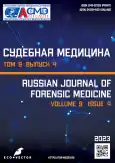Возможности идентификации личности при комплексном исследовании костных останков: случай из практики
- Авторы: Толмачев И.А.1, Лаврукова О.С.2, Антипов А.В.3
-
Учреждения:
- Военно-медицинская академия имени С.М. Кирова
- Петрозаводский государственный университет
- Бюро судебно-медицинской экспертизы республики Карелия
- Выпуск: Том 9, № 4 (2023)
- Страницы: 457-464
- Раздел: Экспертная практика
- URL: https://journal-vniispk.ru/2411-8729/article/view/251340
- DOI: https://doi.org/10.17816/fm15174
- ID: 251340
Цитировать
Полный текст
Аннотация
Одним из сложнейших видов исследований, проводимых в медико-криминалистическом отделении бюро судебно-медицинской экспертизы, является идентификация личности по костным останкам. При исследовании обнаруженных костных останков на первом этапе, как правило, ставятся задачи определения принадлежности костей человеку, а далее ― расовой идентичности, пола, возраста и роста индивидуума. Совокупность установленных характеристик оказывает решающую роль в дальнейшем проведении розыскных мероприятий и идентификации конкретных лиц.
В статье представлен случай из собственной практики. В лесном массиве обнаружены костные останки человека. Установлено, что они принадлежат лицу европеоидной расы мужского пола. Наиболее вероятный рост потерпевшего составлял 173–183,5 см. Анатомо-морфологические особенности костей соответствуют возрасту 49–56,5 лет. Далее была проведена идентификационная экспертиза с изучением рентгенологических снимков, принадлежащих гражданину Н. в возрасте 52 лет, в том числе с использованием метода графических идентификационных алгоритмов. Установлено, что костные останки принадлежат гражданину Н.
Приведённый случай демонстрирует возможности идентификации личности при комплексном исследовании костных останков и подтверждает тот факт, что проблема идентификации неопознанных трупов в судебной медицине является актуальной и в наши дни. Однако до сих пор не предусмотрено конкретного алгоритма применения методов идентификации личности трупа в той или иной ситуации, что создаёт дополнительные трудности в выборе наиболее верной методики (методик). Требуются дальнейшие модернизация и совершенствование методов идентификации личности неопознанного трупа, а поиск новых, более простых, доступных и объективных методов исследования имеет как научный, так и значительный практический интерес.
Ключевые слова
Полный текст
Открыть статью на сайте журналаОб авторах
Игорь Анатольевич Толмачев
Военно-медицинская академия имени С.М. Кирова
Автор, ответственный за переписку.
Email: 5154324@mail.ru
ORCID iD: 0000-0002-5893-520X
SPIN-код: 5794-9030
д-р мед. наук, профессор
Россия, Санкт-ПетербургОльга Сергеевна Лаврукова
Петрозаводский государственный университет
Email: olgalavrukova@yandex.ru
ORCID iD: 0000-0003-0620-9406
SPIN-код: 6395-8638
д-р мед. наук, доцент
Россия, ПетрозаводскАлександр Вячеславович Антипов
Бюро судебно-медицинской экспертизы республики Карелия
Email: sudmedexs7@mail.ru
ORCID iD: 0009-0000-8853-9518
Россия, Петрозаводск
Список литературы
- Сысоев Э.В., Селезнев А.В., Рак И.П., Бурцева Е.В. Новые информационные технологии в судебной экспертизе: учебное пособие. Тамбов: Изд-во Тамб. гос. техн. ун-та, 2006. 84 с.
- Федин И.В., Чикун В.И., Горбунов Н.С., Хлуднева Н.В. Проблема идентификации человека // Вестник судебной медицины. 2017. Т. 6, № 4. С. 40–43.
- Звягин В.Н. Текущие проблемы медико-криминалистической идентификации личности // Проблемы экспертизы в медицине. 2012. Т. 12, № 3-4. С. 39–43.
- Ubelaker D.H., Khosrowshahi H. Estimation of age in forensic anthropology: Historical perspective and recent methodological advances // Forensic Sci Res. 2019. Vol. 4, N 1. Р. 1–9. doi: 10.1080/20961790.2018.1549711
- Lynnerup N. Forensic anthropology and human identification // Scand J Forensic Sci. 2013. Vol. 19, N 1. Р. 16–38. doi: 10.2478/sjfs-2013-0005
- Elliott M., Kurki H., Weston D.A., Collard M. Estimating body mass from skeletal material: New predictive equations and methodological insights from analyses of a known-mass sample of humans // Archaeological Anthropological Sci. 2016. Vol. 8, N 4. Р. 731–750. doi: 10.1007/s12520-015-0252-5
- Долгов А.А., Золотенкова Г.В., Титаренко Е.Н. Структурированный анализ антропологических экспертиз, выполненных в медико-криминалистическом отделе ГБУЗ МО «Бюро СМЭ» в период с 2007 по 2016 год // Судебная медицина. 2018. Т. 4, № 1. С. 17–21. doi: 10.19048/2411-8729-2018-4-1-17-21
- Быков И.Ю., Колкутин В.В., Толмачев И.А., Дмитриев Е.Г. Государственно-правовые и экспертно-идентификационные аспекты охраны права личности граждан Российской Федерации // Военно-медицинский журнал. 2000. Т. 321, № 4. С. 11–14.
- Романько Н.А., Зинин А.М., Хазиев Ш.Н. О судебно-экспертной идентификации личности по признакам внешности и особенностям строения тела // Судебная медицина. 2017. Т. 3, № 1. С. 21–25. doi: 10.19048/2411-8729-2017-3-1-21-25
- Звягин В.Н., Галицкая О.И., Анушкина Е.С. Определение возраста взрослого человека по микроструктуре периостального отдела V плюсневой кости // Судебно-медицинская экспертиза. 2021. Т. 64, № 4. С. 42–46. doi: 10.17116/sudmed20216404142
- Калимуллин Р.Р., Звягин В.Н. Методика диагностики пола взрослого человека по анатомо-морфологическим особенностям черпаловидных хрящей // Судебная медицина. 2021. Т. 7, № 2. С. 83–87. doi: 10.17816/fm392
- Sjovold Т. Tables о the combined method for determination оf age аt death given by Nemeskeri, Harsanyi аnd Acsadi // Anthropologiai Közlemények. 1975. Vol. 19, N 1. Р. 9–22.
Дополнительные файлы















